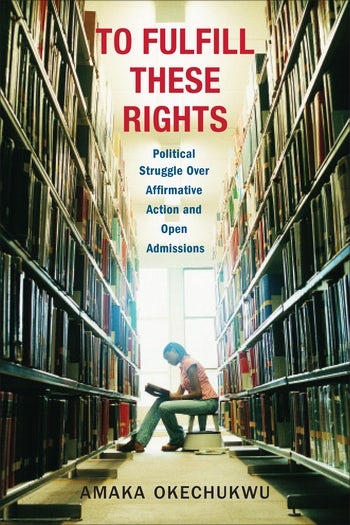Amaka Okechukwu on the Path to Affirmative Action in Higher Education


To continue our celebration of Black History Month, Amaka Okechukwu, author of To Fulfill These Rights: Political Struggle Over Affirmative Action and Open Admissions, reflects on the history and contentious path to affirmative action.
Enter our giveaway for a chance to win a copy of this work and explore more Black History Month posts.
• • • • • •
Black History Month is an important time to remember and celebrate Black life in many forms—the triumphs, the struggles, the exceptional, and the quotidian. Carter G. Woodson’s Negro History Week, which later became Black History Month, was a dedicated time to excavate, grow, and study scholarship on Black life, and quality educational access has always been a significant aspect of Black freedom movements in the United States. In the wake of public debate over elite college admissions, concerning everything from bribery, legacy admissions, and affirmative action policies, it is sometimes easy to forget the struggles that were waged in order to make higher education accessible or that public education was especially seen as a democratizing institution key to social citizenship.
In To Fulfill These Rights: Political Struggle Over Affirmative Action and Open Admissions, in order to understand how racial practices and ideas are developed through political struggle, I explore mobilization over affirmative action in elite public institutions (University of California, University of Michigan, University of Texas–Austin) and open admissions at the City University of New York system. While racial logics of diversity and colorblindness dominate the contemporary discourse of affirmative action, history reminds us that affirmative action emerged as a means of both voluntary and involuntary desegregation.
“While racial logics of diversity and colorblindness dominate the contemporary discourse of affirmative action, history reminds us that affirmative action emerged as a means of both voluntary and involuntary desegregation.”
After decades of struggle in the federal courts, public and private institutions, and the streets, the Civil Rights Movement secured victories, some in the form of civil rights legislation. Title IV of the Civil Rights Act of 1964 outlawed racial, ethnic, gender, and religious discrimination in institutions that received federal funding; it also established the Office for Civil Rights within the Department of Health, Education, and Welfare (HEW) to review cases of discrimination and protect civil rights in these federally assisted institutions, such as colleges and universities. The Office for Civil Rights interpreted the prohibition of discrimination and protection of civil rights in higher education institutions as requiring plans and goals to desegregate faculty and students. These plans, goals, and timelines became known as affirmative action. Though the state claimed that these plans were voluntary, universities could lose federal funding if HEW determined they were in violation.
By 1969, HEW had notified nineteen states that they were at risk of losing their federal funding and ordered them to develop desegregation plans—mandatory affirmative action. Political wrangling meant that the NAACP ultimately sued HEW for not enforcing desegregation after President Nixon fired the director of the Office for Civil Rights. Matthew Shaw’s scholarship shows that these nineteen states were supervised by the federal courts into the 1980s, when they then agreed to continue their affirmative action plans in exchange for the termination of court supervision.1 These states had to implement affirmative action as a direct consequence of past and persisting discrimination in universities. Of these states, three later experienced affirmative action bans: Florida (1999), Oklahoma (2012), and Texas (1996–2003—Texas’s ban was overturned by the Gratz v. Bollinger [2003] Supreme Court decision).
On the other hand, Stulberg and Chen show that most affirmative action plans emerged before federal legislation and developed as voluntary, experimental, institution-specific programs at northern elite universities between 1961 and 1964.2 Liberal university administrators, moved by civil rights mobilization and supported by foundations such as Ford, Rockefeller, Carnegie, and Sloan, initiated affirmative action programs that included recruitment, financial aid, tutoring, and summer bridge programs for small numbers of Black but also Latino and Asian students.
“While they had been admitted through these small, experimental programs, many students felt like second-class citizens on elite campuses.”
Black students, as well as other students of color, in small numbers on campuses with voluntary and mandatory plans, demanded more aggressive affirmative action that included higher representation of students and faculty of color, Black and Ethnic Studies Departments, and more financial aid. While they had been admitted through these small, experimental programs, many students felt like second-class citizens on elite campuses. Some students initiated their own student-led recruitment programs, such as in Texas and California, in lieu of an institutional commitment to desegregation. Campus-led movements, including demonstrations, rallies, strikes, and civil unrest (students at University of Michigan shut down the university library by pulling hundreds of books off the shelves) pushed university administrators to make bigger concessions, providing more student services to minority and first-generation students, establishing minority student centers and affinity-focused housing and a (fluctuating) commitment to higher numbers of students of color. After the Regents of University of California v. Bakke (1978) decision, which outlawed racial quotas but asserted diversity as a compelling state interest, diversity (rather than desegregation or racial redress) became the only legally defendable reason to implement voluntary affirmative action.
“To be sure, affirmative action was always vulnerable to challenge.”
To be sure, affirmative action was always vulnerable to challenge. The federal government never set clear guidelines, leaving institutions to develop their own affirmative action plans. Parallel tracks of voluntary and mandatory development did not clarify how institutions should measure “equality.” Much of the contemporary guidelines for affirmative action has been developed in the courts as a consequence of the many lawsuits that have been waged in the name of “reverse discrimination” by conservative organizations.
The Reagan administration did much to undermine employment affirmative action in the 1980s, and the persisting lawsuits against affirmative action in universities, including the recent Students for Fair Admissions v. Harvard case, continue to restrict the means by which institutions can legally implement affirmative action. Additionally, conservatives have so thoroughly appropriated and exploited the language of discrimination and symbolism of civil rights that public discourse often reflects an inaccurate picture of past and persisting discrimination.
Civil rights mobilization and political struggle over affirmative action illustrate both the possibilities and limitations of state concessions to social movements. Affirmative action is partially responsible for the expansion of the Black middle class in the post–Civil Rights period. However, reform policies, meant to serve short-term outcomes, are limited in remedying structural oppression—especially with wavering state commitment. During Black History Month, we should remember our victories; however, let us also remember what we have lost so that we can learn from the past and apply these insights to contemporary social justice struggles.



